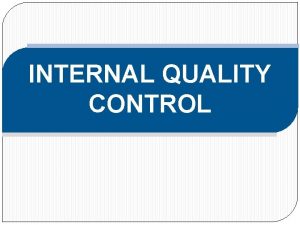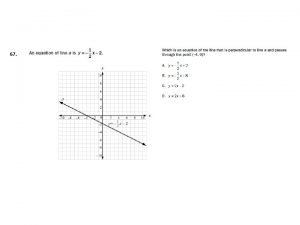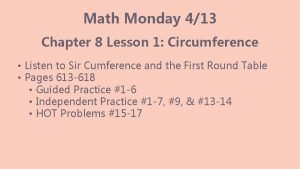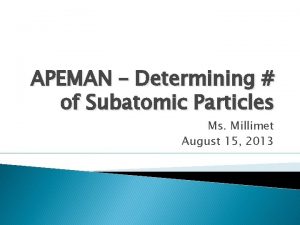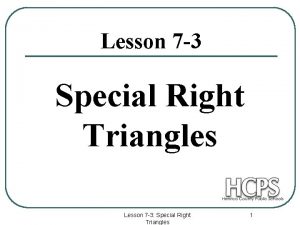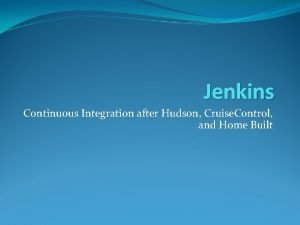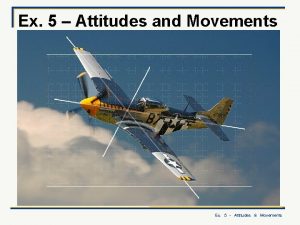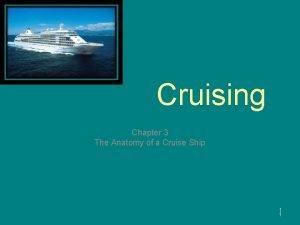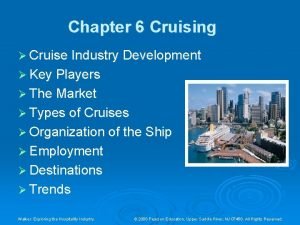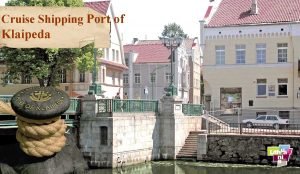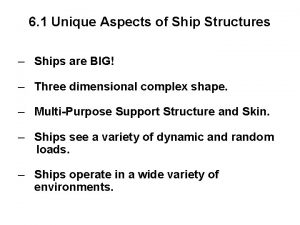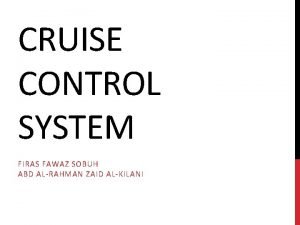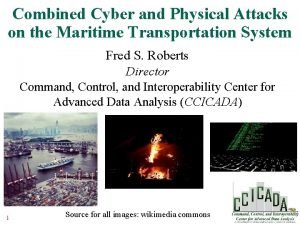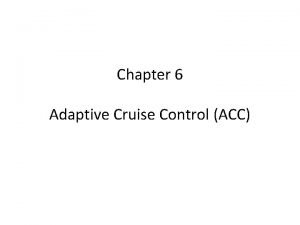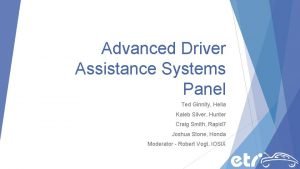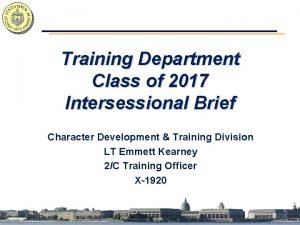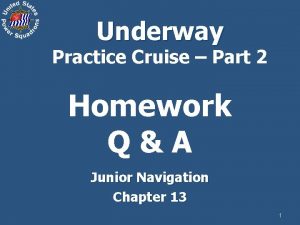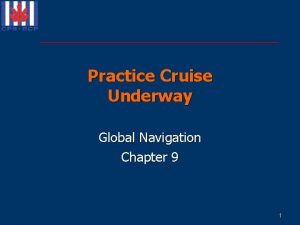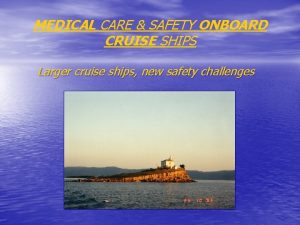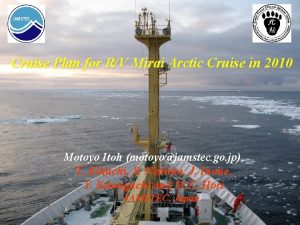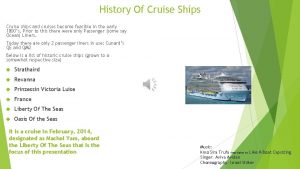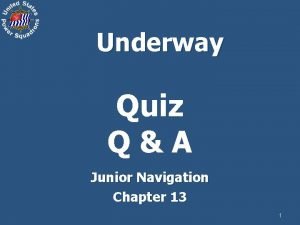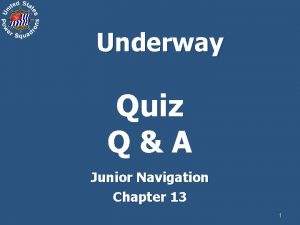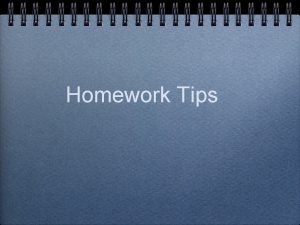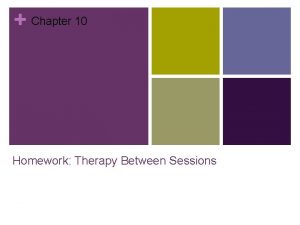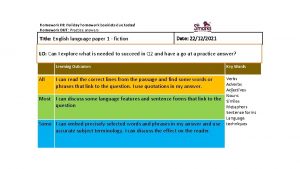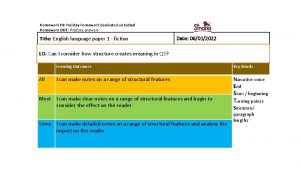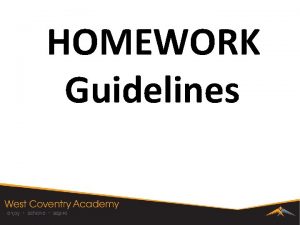Underway Practice Cruise Part 2 Homework QA Junior






































- Slides: 38

Underway Practice Cruise – Part 2 Homework Q&A Junior Navigation Chapter 13 1

The homework for this Chapter consists of executing a portion of the voyage that you planned for in Chapter 11. This Practice Cruise will provide a review of the entire course and help you prepare for the course exam. 2

To complete this cruise, you will need: • your Navigator’s notebook and the completed homework from Chapter 11; • the pilot chart for July included with your student material; • the Excerpts from the Nautical Almanac, contained in Appendix B of your Student Manual, for all daily data and Altitude corrections to complete the sight reductions; • a copy of any edition of the Nautical Almanac for the “Increments & Corrections” tables; • blank copies of the Meridian Transit Form included at the end of Chapter 9; • blank copies of the Deck Log included at the end of this chapter; • Universal Plotting Sheets, Sight Reduction forms and CLS plotting sheets, included with your student materials. 3

Practice Offshore Cruise - Underway The critical items in your Navigator’s notebook related to taking celestial observations are: ■ Height of eye: 10. 0 ft ■ Index Error (IE): Off the Arc, 0° 01. 9’ (Check before each observation) ■ Watch error (WE): f 0 -13 seconds This leg of your cruise starts on 29 June 20 XX. 4

1. As part of your planning, you divided this voyage into 3 segments (Chapter 11 homework, Question #2) and planned to plot each voyage segment on a separate Universal Plotting Sheet (UPS). You completed the first segment of the voyage and are about to start the second voyage segment. • Prepare UPS No. 2, using the Mid-Latitude of 37°N and Mid-Longitude of 68° W. • From your voyage plan, you note that the variation in this area is 15° W. Plot the 15° W isogonic line using points L 1 39° 00’N, Lo 1 69° 20’W and L 2 35° 00’N, Lo 2 66° 45’W. • You also note that this UPS includes an area where the time zone changes. Plot the appropriate time zone boundary on UPS No. 2. • You locate two waypoints on Plotting Sheet No. 2 to mark the intended course for this voyage segment. Plot and label WP 1 at LWP 1 38° 18. 8’N, Lo. WP 1 69° 14. 3’W, and WP 2 at LWP 2 35° 37. 5’N, Lo. WP 2 67° 03. 5’W. 5

Problem 1. Continued from previous slide a. What is the magnetic course along the 162°M rhumb line of this segment? ______ Click to view Ships Compass Deviation Table b. What should be the planned compass 160° course along this rhumb line? ______ 6

2. You transfer data from your Navigator’s notebook and review the pilot chart. You note that your intended route for this segment crosses two major shipping lanes, Cape Hatteras to Virgin Rocks and Cape Hatteras to Gibraltar (Chapter 11 homework, #1 h). You mark the intersection of the shipping lanes and your route with WP 3 for the Virgin Rocks route and WP 4 for the Gibraltar route, and check these waypoints in your GPS. You also make a note in your Navigator’s notebook to closely monitor the radar when in the region of the two waypoints, based on the captain’s standing orders regarding radar contacts. ■ Plot WP 3 & WP 4, as well as the course these shipping lanes cross your rhumb line course, on your Plotting Sheet #2. The data recorded in your Navigator’s notebook is: WP 3: L 37° 50’N, Lo 68° 20’W. Course 058° WP 4: L 36° 40’N, Lo 67° 20’W. Course 071° 8

3. 0400. You are finishing the first watch of the day. The ship’s heading, psc, is 133° C and speed has been 6. 8 kn. The GPS indicates a position of L 38° 34. 1’N, Lo 69° 49. 5’W. The ship’s knotmeter log reading is 0579. 0. Conditions overnight have been Force 3 winds. 119° a. What is the true DR Course? _______ b. At 0400, what is the range and bearing to the 31. 5 nm, 119°T GPS waypoint WP 1? _______ • 0428. Received NOAA weather fax; logged receipt and placed copy in Navigator’s notebook. 9

4. 0800. The GPS indicates a position of L 38° 26. 6’N, Lo 69° 16. 2’W. The ship’s heading is 133°C and the knotmeter log reading is 0606. 1. Wind is Force 3 with scattered white caps. You report the position to the captain. • Plot the 0800 GPS Fix and DR, and the CMG from the 0400 GPS fix on a CLS plotting sheet, using L 38° 30. 0’N and Lo 69° 30. 0’W for the mid-Lat and mid-Longitude. a. What has been the true CMG from the 0400 GPS Fix? 106° _____ 6. 8 kn b. What has been the SMG? ______ (use the knotmeter log readings to determine this) L 38° 21. 0’N, Lo 69° 19. 3’W c. What are the 0800 DR coordinates? __________ Set 023°, Dft. 1. 5 kn d. What is the set and drift at 0800? ________ Click to view 0800 Set & Drift CLS Plotting Sheet Solution 10

5. The current has put you off course to the northeast, so you decide to restart your DR course from the 0800 GPS fix to WP 1. Weather and wind conditions have remained constant so you estimate your speed will be 6. 8 kn for this leg. • Draw a current vector diagram to determine the true course to allow for the current determined in Question #4. Click to view 0800 Current Vector Diagram a. What is the true course from the 0800 GPS fix to 169° WP 1, not adjusting for current? _______ b. What is the true course from the 0800 GPS fix to 175° WP 1, adjusting for current? ______ 5. 4 kn c. What is your expected SOA? _______ d. What is the compass course to WP 1, adjusting 187° for current? ______ 12

6. 0910: You reach WP 1 and change course to go towards WP 2. You check the plotted course line between WP 1 and WP 2 and confirm it to be 147°T. Knotmeter log reading is 0614. 0. • You wish to confirm the GPS position readings by getting a RFix using an LOP of the sun, and later in the day, a Meridian Transit of the sun. • At 09 -15 -15 you obtain a good observation on the Sun’s upper limb and record an hs of 55° 59. 5’. The 0915 GPS position is L 38° 18. 7’N, Lo 69° 14. 2’W and the knotmeter reading is 0614. 1. • Reduce this sight. Plot the reduced sight on a CLS plotting sheet, using L 38°N and Lo 69°W for the mid- Lat and mid-Longitude, and determine the 0915 EP. 14

Problem 6. Continued from previous slide 55° 41. 8’ a. What is Ho? ____ 5. 0 nm Toward b. What is the intercept? _______ 105° c. What is the azimuth? _____ Click to view solution on Sight Reduction Form d. What are the 0915 EP coordinates? L 38° 17. 4’N, Lo 69° 08. 0’W __________ Click to view CLS Plot of 0915 EP 15

7. 1000. In preparing to take a Meridian Transit sight, you want to calculate the time that transit of the sun will occur. Based on the time of yesterday’s Meridian Transit, you estimate that Meridian Transit will occur today around ZT 1140. Your 1000 GPS position is L 38° 14. 0’N, Lo 69° 11. 0’W and knotmeter log reads 0619. 6. Winds have increased, waves 1 -2 ft. • Plot your 1140 DR position on Plotting Sheet #2. a. What is your 1140 DR position? L 38° 03. 8’N, Lo 69° 02. 6’W ___________ b. Using your 1140 DR Lo, what is the calculated ZT 11 -39 -37 time of MT? ______ • 1052. Received NOAA weather fax; logged receipt and placed copy in Navigator’s notebook. 18

8. 1130. You prepare to take sights for the Meridian Transit and start before your calculated time of MT. You take a run of sights and select the observation on the lower limb of the sun at WT 11 -39 -48 with hs of 74° 56. 1’. You note that the 1140 GPS position is L 38° 03. 5’N, Lo 69° 02. 1’W and the knotmeter log reads 0632. 2. • Reduce the sight, using the Meridian Transit Form contained at the end of Chapter 9. 19

Problem 8. Continued from previous slide 75° 10. 6’ a. What is Ho? _____ b. What is the calculated latitude from your L 38° 01. 5’N meridian transit sight? _____ c. What is the difference between the calculated latitude from your MT sight and the latitude 2. 0 nm given by the GPS? ____ Click to view solution on Meridian Transit Form 20

9. Plot the MT observation on the CLS plotting sheet you prepared for Question #6. Advance the 0911 Sun LOP for a RFix with the 1140 MT. a. What are the coordinates of the 1140 RFix? L 38° 01. 5’N, Lo 68° 56. 8’W ___________ b. What is the distance between the 1140 GPS fix and 4. 6 nm the 1140 RFix? _______ YES c. Does the RFix confirm the GPS reading? _____ (a difference of anything less than approx 10 nm is OK) Click to view CLS Plot of 1140 RFix • With the distance between the 1140 GPS fix and 1140 RFix small, you’re now confident that the GPS is working properly. You decide to re-start your DR course line from 22 your next GPS fix

10. 1200. The GPS indicates a position of L 38° 01. 0’N, Lo 69° 00. 0’W and the knotmeter log reading is 0635. 2. Winds are Force 4 with waves 2 -3 ft. After you make your entry in the ship’s Deck log and report the position to the captain, you check on the NOAA radiofax chart issued at the 1052 weather broadcast. The low pressure system that you had been following during previous forecasts, located off the Carolina coast, is developing faster than expected. • The forecast indicates that the system is on a course of 035° at a speed of 13 mph and is predicted to cross L 35° 00’N, Lo 75° 00’W in 24 hours. • After conferring with the captain, you decide to avoid the worst of the system by changing to a course that is 90 degrees to the system’s track. • Plot this course from the 1200 position and locate WP 5 150 miles from the 1200 position. 24

Problem 10. Continued from previous slide a. What is the true course heading to WP 5? 125° _____ b. What is the compass course to WP 5? 139° _____ c. What are the coordinates of WP 5? L 36° 35. 0’N, Lo 66° 25. 5’W _____________ 25

Problem 10. Continued from previous slide ■ Further evaluation of the weather data indicates that the system is approximately 200 miles in diameter with winds that could approach Force 5. You note that the winds will shift from the SW to S, and then to the SE as the system passes. You decide to: • Start logging your GPS position every two hours until the weather system passes. • Add to the watch orders instructions to create a route between the 1200 Fix and WP 5. • Instruct the helmsman of the watch to follow the GPS route to WP 5, but to also follow the winds to minimize the strain on the boat and crew. 26

11. 1400. The GPS position is L 37° 57. 9’N, Lo 68° 39. 8’W and the knotmeter log reads 0651. 4. Winds are at Force 4 and increasing. • Plot the 1400 position on Plotting Sheet #2, and make the appropriate Deck Log entry. 27

12. 1600. The knotmeter log reads 0669. 0 and the GPS position is L 37° 54. 6’N, Lo 68° 17. 9’W. Winds have increased to Force 5, waves to 5 ft with some spray. After plotting and logging the 1600 GPS position you compare the past two log entries with your plotting sheet. You make note that the SMG for the past 4 hours has been 8. 5 kn. You note that the 1600 GPS position is to the NE of the course line to WP 5; this doesn’t concern you, since helmsman was instructed to follow the winds to minimize the strain on the boat and crew, and the winds from the storm have been primarily from the SW. You also note that the 1600 position is very close to the shipping lane between Cape Hatteras and Virgin Rock. 28

Problem 12. Continued from previous slide • You immediately have the radar turned ON, and confirm it is operating and being monitored by one of the crew. • Plot the 1600 GPS position on Plotting Sheet #2, and make the appropriate Deck Log entry. a. What is your distance from your 1600 position to the nm Cape Hatteras to Virgin Rock shipping lane? 4. 0 ______ 29

13. 1614. The radar picks up a large contact at a range of 25. 5 nm, on a bearing of 073°T; the GPS position at this time is L 37° 54. 2’N, Lo 68° 15. 4’W and the knotmeter log reads 0671. 1. Twenty minutes later, the GPS indicates your position is L 37° 53. 6’N, Lo 68° 11. 7’W with knotmeter log reading 0674. 0; a second radar reading at this time indicates the contact at a range of 15. 8 nm, bearing 074°T. • Plot this situation on a CLS plotting sheet, using L 38°N and Lo 68° 10’ W for the mid-Lat and mid-Longitude. 30

Problem 13. Continued from previous slide 235° (+/- 5°) a. What is the ship’s course? _______ 21 kn (+/- 1 kn) b. What is the ship’s speed? ________ c. What time will the ship cross your course line? 1704 (+/- 1 min) ________ d. What are the DR coordinates at that time? L 37° 52. 7’N, Lo 68° 06. 5’W ____________ 31

Problem 13. Continued from previous slide • You note the ship’s closest point of approach (CPA) is approximately 2. 0 nm and within the captain’s standing orders to avoid being within 4. 0 nm of other ships. e. To alleviate this CPA situation, what true course 055° (+/- 5° ) should you change to? ________ (180° from the ship’s course) f. What is the compass course for the action taken? 071° (+/- 5°) _______ 32

Problem 13. Continued from previous slide • Due to the small scale on UPS No. 2, you choose not to plot this course change; however, you enter this information in the ship’s Deck Log, as well as report this to the Captain. • 1652. Received NOAA weather fax; logged receipt and placed copy in Navigator’s notebook. • 1704. The GPS indicates a position of L 37° 56. 4’N, Lo 68° 06. 1’W. The knotmeter log reads 0679. 2. 33

Problem 13. Continued from previous slide Winds are F 5, with waves 6 ft. The ship is now well past your position, so you return to the original course to WP 5 of 139° (psc) and restart the course line from the 1704 GPS position. Due to the winds and sea state, you continue the 1200 orders to the helmsman to follow the wind to minimize stress on the boat and crew. You expect the weather conditions to continue to set the boat to the NE. You decide to plot the 1600 to 1704 events on the UPS sheet by only plotting the two GPS positions for those times and placing a note referencing the CLS plotting sheet. Click to view Ship Crossing CLS Plotting Sheet 34

14. 1730. In checking your DR plot of the past several hours, you decide to determine the set and drift indicated by the 1600 GPS fix. You use the 1600 knotmeter log reading to calculate the speed and distance from the 1200 GPS position, and you plot the 1600 DR and the GPS positions on a CLS plotting sheet, using L 38°N and Lo 68° 30’ W for the mid-Lat and mid-Longitude. a. What are the 1600 DR coordinates? L 37° 41. 6’N, Lo 68° 24. 9’W _____________ 023° b. What is the set at 1600? _____ 3. 5 kn c. What is the drift at 1600? ______ Click to view 1600 Set & Drift CLS Plotting Sheet d. What was the true CMG between 1200 and 1600? 101° ____ 36

Problem 14. Continued from previous slide • You choose not to make a change in course to compensate for the current since the orders for the helmsman are to continue to follow the wind to minimize the stress on the boat and crew. However, you log the set and drift information. 38

15. 1800. The GPS indicates your position is L 37° 54. 7’N, Lo 67° 57. 2’W and the knotmeter log reads 0686. 3 when you make your Deck Log entry. Winds have dropped but are still at Force 5 and waves are running to 4 -5 ft. You review the 1642 weather fax and find that the storm is predicted to pass your present position quickly and that winds should start to moderate in the next hour. 39

16. 1900. GPS position is L 37° 53. 2’N, Lo 67° 46. 6’W and the knotmeter log reads 0695. 0. The winds have dropped to Force 4, seas at 3 -4 ft. With the improving conditions, you consider changing course towards WP 2, your original waypoint for this leg of the voyage. a. What is true course from the 1900 GPS position to WP 2? ______ 166° T • Based on wind direction and strength, as well as your experience with your boat, you estimate your boat will be set to the NE about 8° for this course. • Draw a diagram illustrating the correction you will need to make for leeway, in order to stay on the DR track you determined to WP 2. 40

Problem 16. Continued from previous slide b. Based on your diagram, what is the true course to 174° T WP 2, correcting for leeway? _______ Click to view solution for 1900 Leeway Correction c. What compass course do you need to steer to remain 186° on your intended track to WP 2? _____ • You instruct the helmsman to change course to WP 2, and to steer this compass course to remain on the intended track to WP 2. 41

17. 2000. You record the GPS position of L 37° 45. 5’N, Lo 67° 44. 2’W in the Deck Log and report this position to the captain. The knotmeter log reads 0703. 0. The winds continue to moderate slightly and sea conditions improving. • Plot your 2000 position. 43

18. 2200. You log the GPS position of L 37° 29. 9’N, Lo 67° 39. 9’W and the knotmeter reading of 0719. 0. Winds are at F 4, with waves at 3 -4 ft. • Plot your 2200 position. 44

19. 2400/0000. You finish up the task for the day by reviewing the Deck Log and making the 2400/0000 entry. You log the GPS position of L 37° 14. 4’N, Lo 67° 34. 4’W and the knotmeter reading of 0735. 0. Winds have dropped to F 3 and conditions are improving. You plot this position on Plotting Sheet #2 and label the change of date. a. What changes need to be made in the Log? Start a new page with new date. _______________ • 0024. Received NOAA weather fax; logged receipt and placed copy in Navigator’s notebook. Click to view 29 June Deck Log 45

20. 0200. You log the GPS position of L 36° 58. 9’N, Lo 67° 29. 6’W; the knotmeter reading is 0751. 3. ■ Plot your 0200 position. a. How do you label this 0200 position on your plotting sheet? 0200 GPS (ZD+5) / 0300 GPS (ZD+4) __________________ b. How do you record the time in the Deck Log? ’ZD+4’ in the ‘Time’ column of Log; on next ____________________ line, enter time of 0300. ___________ • Having only caught naps throughout the storm, you turn over the watch and head to your berth for some well-earned rest. Click to view 30 June Deck Log 47

Plot of Cruise Your plot should look something like this. 49

Q 7 Underway Practice Cruise – Part 2 End Of Homework Q&A Junior Navigation Chapter 13 50
 Internal qc ok
Internal qc ok Westgard rules 10x
Westgard rules 10x Homework oh homework i hate you you stink
Homework oh homework i hate you you stink Homework oh homework i hate you you stink
Homework oh homework i hate you you stink Jack prelutsky homework oh homework
Jack prelutsky homework oh homework Homework oh homework
Homework oh homework Homework oh homework i hate you you stink
Homework oh homework i hate you you stink Literal language
Literal language Independent events probability
Independent events probability Lesson 1 reteach circumference answer key
Lesson 1 reteach circumference answer key Lesson 8-1 identifying quadratic functions
Lesson 8-1 identifying quadratic functions Assigning homework and providing practice
Assigning homework and providing practice Ape man practice
Ape man practice Lesson 7-3
Lesson 7-3 Disney cruise youth activities counselor
Disney cruise youth activities counselor Tom cruise dyslexia
Tom cruise dyslexia Cruise control continuous integration
Cruise control continuous integration Cruise attitude
Cruise attitude Anatomy of cruise
Anatomy of cruise Simulink cruise control
Simulink cruise control Key players in cruise industry
Key players in cruise industry Adaptive cruise control embedded system
Adaptive cruise control embedded system Lithuania cruise port
Lithuania cruise port Ship structural components
Ship structural components International cruise & excursions inc
International cruise & excursions inc Hudson jenkins history
Hudson jenkins history Adaptive cruise control
Adaptive cruise control Firas fawaz
Firas fawaz Cruise ship pentest
Cruise ship pentest Adaptive cruise control diagram
Adaptive cruise control diagram Adaptive cruise control
Adaptive cruise control Treasure island cruise
Treasure island cruise Midsweb usna
Midsweb usna The cruise-control function on georgina's car
The cruise-control function on georgina's car European cruise council
European cruise council Plasma kallikrein
Plasma kallikrein Addition symbol
Addition symbol Part to part ratio definition
Part to part ratio definition Brainpop ratios
Brainpop ratios

